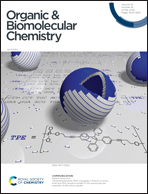Phosphorothioate modification improves exon-skipping of antisense oligonucleotides based on sulfonyl phosphoramidates in mdx mouse myotubes†
Abstract
2′-O-Methyl (2′-OMe) antisense oligonucleotides (AOs) possessing a various number of 4-(trimethylammonio)butylsulfonyl or tosyl phosphoramidates (N+ and Ts-modifications, respectively) instead of a native phosphodiester linkage were designed to skip exon-23 in dystrophin pre-mRNA transcript in mdx mice myotubes. AOs bearing several zwitterionic N+ modifications in the sequence had remarkably increased thermal stability towards complementary mRNA in comparison with 2′-OMe-RNAs having negatively charged Ts and phosphorothioate (PS) linkages. However, only Ts-modified AOs exhibited a similar level of exon skipping in comparison with fully modified PS-containing 2′-OMe-RNA, whereas the exon skipping induced by N+ modified AOs was much lower with no exon-skipping detected for AOs having seven N+ modifications. The level of exon-skipping was improved once Ts and especially N+ moieties were used in combination with PS-modification, most likely through improved cellular and nuclear uptake of AOs. These results provide new insights on expanding the design of novel chemically modified AOs based on phosphate modifications.



 Please wait while we load your content...
Please wait while we load your content...